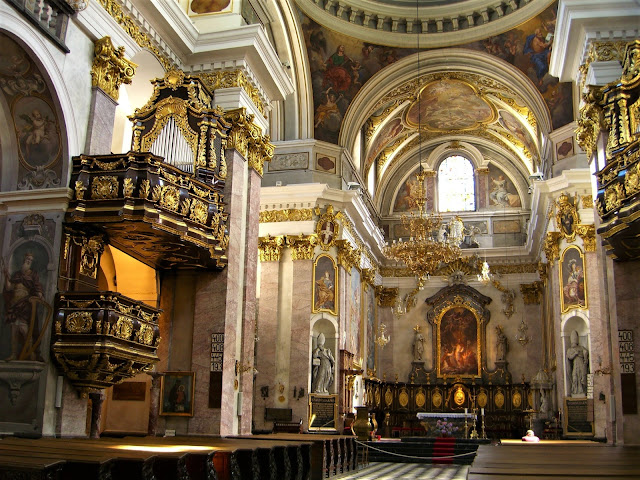The symbol of Ljubljana, capital city of Slovenia, is the Ljubljana Dragon. According to myth, the slaying of a dragon brought a bounty of water to the land, ensuring the fertility of the Earth. Oddly, this is said to have also created the Ljubljana Marshes, which periodically threaten Ljubljana with flooding. The people of Slovenia thus have an ancient love-hate kind of thing with their mascot.
The Ljubljanica River may be unimaginatively named, but it has a colorful history. It seems that this river has served as a sort of ritualistic dumping ground for various civilizations over thousands of years. From the Stone Age to the Renaissance the Romans and the Celts and innumerable lesser-known and unnamed peoples have offered their artifacts, dropped their wallets and tossed out their trash in the waters between here and Vrhnika, about twenty kilometers upstream. The inevitable clash between historians and treasure hunters compelled Slovenia's national parliament to declare the river a site of cultural importance, making it illegal to dive without a permit. Swim at your own risk.
The Ljubljanica River winds east then northeast out of town where it joins the Sava River. The Sava, not to be outdone by the rich history of the Ljubljanica, crawls like a snake on methamphetamines across the Slovenian countryside and into Croatia, side-winding south of Zagreb and down to where it looks like it got stepped on because there it really goes into a tizzy, carving out the twisting, tortured border between Croatia and Bosnia-Herzegovina before crashing into the Danube in the Bosnian capital of Belgrade, ending its almost 1,000-kilometer acid trip.
You can't tell from here but this bridge is actually one part of the Tromostovje, three historically significant bridges over the Ljubljanica River. The center bridge was built in 1842, replacing an old but geographically significant and strategically important wooden bridge. Ninety years later famed architect and favorite Slovenian son Jože Plečnik added a pedestrian bridge on each side, creating this Triple Bridge that is now the social and touristic center of Ljubljana's beautiful Old Town.
I could write pages about (i.e. plagiarize all the pertinent info about) Ljubljana's Cathedral, the Church of St. Nicholas. This site was occupied by a Romanic church at least as far back as 1262. After a fire in the middle of the 14th Century it was rebuilt in the Gothic style. It was burned down in the 15th Century (most likely by the Turks), was rebuilt in the Baroque style at the beginning of the 18th Century, and had its dome added in 1841.
Fascinating history, to be sure. But I'll simply say that of all the churches I've ever set foot in, this one might be my all-time favorite.
The first time I visited Prague, back in 1992, the Václavské náměstí, the long road leading up to the Narodni Muzeum, was unsophisticated, unpolished, and more than a little rough around the edges. In other words, it was genuine. Fifteen years later I went back and found a bright and shiny boulevard of bullshit. The same sort of thing seems to be happening everywhere, from Cambodia to Cuzco to Takayama, Japan. Which makes unvarnished neighborhoods like this even more alluring to me.
Likewise, the old open-air markets that give such vibrancy to countless cities and towns around the world are among the first things I look for wherever I go. Also like the organic feel of so many places succumbing to the tourist trade, markets like this are also disappearing, or at least suffering, overrun by the crush of the cheap, air-conditioned convenience of the modern and personality-challenged supermarket.
Support your local farmers.
The Fountain of Three Carniolan Rivers stands in Mestni trg Square, featuring three river gods believed to represent the Sava, the Ljubljanica, and the Krka Rivers. This Baroque piece of waterworks is also known as the Robba Fountain, named for Venetian-born sculptor Francesco Robba who, after spending most of his celebrated life in Ljubljana, basically went broke working on this fountain and, when he was finished, left for Zagreb where he eventually died.
This was the prevailing story anyway, until the turn of the 21st Century when evidence was found that pointed to Robba living out his life in Ljubljana.
That a guy can create something like this fountain, and many other masterpieces like it, and then go broke and die without people even knowing for sure where makes me think Robba was not much of a people person.
Ljubljana Castle stands on a hilltop overlooking the Old Town and the rest of the city. The first castle is believed to have been constructed in the 11th Century, although records suggest this place has seen continuous habitation since 1200 BC.
A fortress before its promotion, Ljubljana Castle has also served as an arsenal, a barracks, a military hospital, a prison, a housing project, a wedding venue, a cultural events center, and now a museum. The grounds are also a great place to hang out and enjoy the view.
Adding to the allure of Ljubljana Castle, and to the pleasure of a visit to this Old Town overall, are the various trails leading through the relative quietude of the wooded hillsides. And while visitors to Slovenia and Ljubljana may be on the rise, there remain (I hope) those places where things are still real.











No comments:
Post a Comment